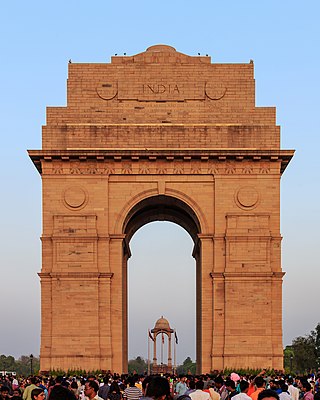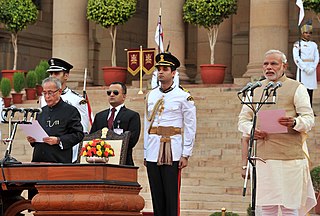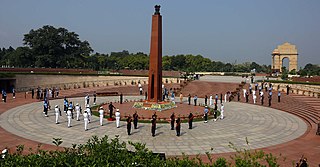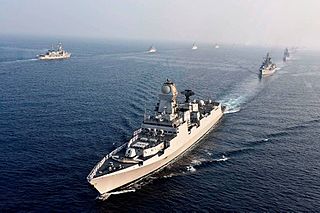
Narendra Damodardas Modi is an Indian politician serving as the 14th and current prime minister of India since May 2014. Modi was the chief minister of Gujarat from 2001 to 2014 and is the Member of Parliament from Varanasi. He is a member of the Bharatiya Janata Party (BJP) and of the Rashtriya Swayamsevak Sangh (RSS), a right-wing Hindu nationalist paramilitary volunteer organisation. He is the longest serving prime minister from outside the Indian National Congress.

7, Lok Kalyan Marg, formerly 7, Race Course Road, is the official residence and principal workplace of the Prime Minister of India. Situated on Lok Kalyan Marg, New Delhi, the official name of the Prime Minister's residence complex is Panchavati. It is spread over 4.9 hectares of land, comprising five bungalows in Lutyens' Delhi, built in the 1980s, which are the Prime Minister's office, residency zone and security establishment, including one occupied by Special Protection Group (SPG) and another being a guest house. However, even though there are 5 bungalows, they are collectively called 7, Lok Kalyan Marg. It does not house the Prime Minister's Office but has a conference room for informal meetings.

The India Gate is a war memorial located near the Kartavya path on the eastern edge of the "ceremonial axis" of New Delhi, formerly called duty path. It stands as a memorial to 84,000 soldiers of the British Indian Army who died between 1914 and 1921 in the First World War, in France, Flanders, Mesopotamia, Persia, East Africa, Gallipoli and elsewhere in the Near and the Far East, and the Third Anglo-Afghan War. 13,300 servicemen's names, including some soldiers and officers from the United Kingdom, are inscribed on the gate. Designed by Sir Edwin Lutyens, the gate evokes the architectural style of the memorial arch such as the Arch of Constantine, in Rome, and is often compared to the Arc de Triomphe in Paris, and the Gateway of India in Mumbai.
The Eastern Peripheral Expressway (EPE) or Kundli–Ghaziabad–Palwal Expressway is a 135 km (84 mi) long, 6-lane wide expressway passing through the states of Haryana and Uttar Pradesh in India. The expressway starts from the Western Peripheral Expressway at Kundli, Sonipat, passing through Baghpat, Ghaziabad and Noida districts in UP and Faridabad district in Haryana before rejoining the Western Peripheral Expressway near Dholagarh, Palwal. Eastern Peripheral Expressway along with Western Peripheral Expressway completes the largest Ring Road around Delhi. The Eastern Peripheral Expressway was declared as National Expressway 2 (NE-2) in March 2006.
Martyrs' Day are days declared in India to honour recognised martyrs of the nation.

Rashtriya Raksha University (RRU), formerly Raksha Shakti University (RSU), is a central university and an Institute of National Importance located in Gandhinagar, Gujarat, India. It has a specialization in national and internal security. It is not to be confused with the Indian Defence University (IDU) which is focused on the Indian military, whereas RRU is focused on the police and para-military Central Armed Police Forces (CAPF).
One Rank One Pension (OROP), or "same pension, for same rank, for same length of service, irrespective of the date of retirement", is a longstanding demand of the Indian armed forces and veterans. The demand for pay-pension equity, which underlies the OROP concept, was provoked by the exparte decision by the Indira Gandhi-led Indian National Congress (INC) government, in 1973, two years after the historic victory in the 1971 Bangladesh war.

Narendra Modi, parliamentary leader of the Bharatiya Janata Party, started the first tenure of his prime ministership, after his swearing-in as the 14th Prime Minister of India on 26 May 2014. 45 other ministers were also sworn in along with Modi. The ceremony was noted by media for being the first ever swearing-in of an Indian Prime Minister to have been attended by the heads of all SAARC countries.

The National War Memorial in India is a national monument built to honour and remember soldiers of the Indian military who fought in armed conflicts of independent India. The names of armed forces personnel killed during the armed conflicts with Pakistan and China as well as the 1961 War in Goa, Operation Pawan, and other operations such as Operation Rakshak are inscribed on the memorial walls in golden letters.
The following is a timeline of the Premiership of Narendra Modi from his inauguration as Prime Minister of India on 26 May 2014 till now. The following are the highlights of the major events that took place under his premiership.

Purvanchal Expressway is a 340.8 km long, 6-lane wide access-controlled expressway in the state of Uttar Pradesh, India. The expressway connects Chand Saray village near Gosainganj in Lucknow district with Haydaria village on NH-31 in Ghazipur district. It is developed by the Uttar Pradesh Expressways Industrial Development Authority (UPEIDA). The Purvanchal Expressway has a 3.2 km long airstrip at Akhalkiri Karwat village near Kurebhar in Sultanpur district for emergency landing of aircraft. The construction work was started by the UPEIDA on 10 October 2018 and was inaugurated and opened to the public on 16 November 2021.

International Fleet Review 2016 was an international maritime exercise hosted and conducted by the Indian Navy on behalf of the President of India in February 2016 to improve relations with other navies in the region. The Indian Navy demonstrated its maritime capabilities to the foreign navies participating in the review.

National Highway 275 (NH-275), also commonly referred to as Bengaluru–Mysuru Expressway, part of the Bangalore–Mangalore Economic Corridor (EC-34), is a national highway that starts from Bengaluru and goes through Mysuru as a 10-lane expressway of 119 km (74 mi), and again as 4-lane till Bilikere, and ends at Bantwal. This highway connects the coastal city of Mangaluru to Bengaluru. It is also a bypass route for the National Highway 75 (NH-75). The Bengaluru to Mysuru section of this highway was upgraded from 4 to 10 lanes, out of which the 6-lane section is the main elevated access-controlled carriageway and the other 2-lane section on both ends of the carriageway are service roads. It claims to reduce the travel time between Bengaluru and Mysuru from 3 hours to 75 minutes.

Amar Jawan Jyoti is an Indian memorial conceptualised and constructed after the Indo-Pakistani War of 1971 and inaugurated on 26 January 1972. It was the national war memorial in India until February 2019, when the new National War Memorial and its own flame was inaugurated and lit. On 21 January 2022, the older flame was merged with the newer one at National War Memorial.
Azadi Ka Amrit Mahotsav or 75th Anniversary of Indian Independence was an event, in which the 75th Anniversary of the Independence of India was celebrated in India and abroad. It was 75th Independence Day of India.
Events in the year 2022 in India.
Adwaita Gadanayak is an Indian sculptor.

The "Dr. A. P. J. Abdul Kalam National Memorial" is a mausoleum in memory of A. P. J. Abdul Kalam (1931–2015), the 11th President of India (2002-2007), located in his home town, Rameswaram, Tamil Nadu, India. The memorial was designed and constructed by Defence Research and Development Organisation (DRDO) as a tribute to Kalam and to display the cultural heritage and ethnic diversity of India. It was officially inaugurated by Prime Minister Narendra Modi in July 2017. A symbol of national integration, the memorial is an amalgamation of Mughal and Indian architecture.

Dr. Ambedkar National Memorial, also known as also known as Mahaparinirvan Bhoomi or Mahaparinirvan Sthal, is a memorial in India's national capital New Delhi, dedicated to anti-caste activist and political leader B. R. Ambedkar. The site is the location of 26 Alipur Road, a now-demolished bungalow where Ambedkar lived from 1951 until his death in 1956.





















